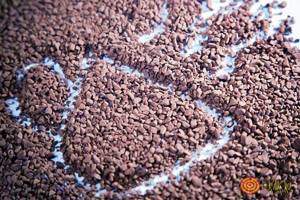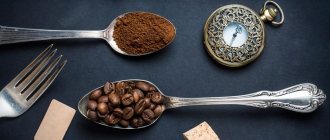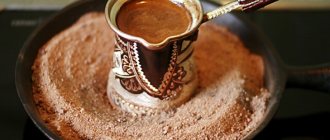History of instant coffee
Coffee as a natural energy drink is good for everyone, except for one thing: it is too difficult to prepare in the field. Therefore, already in the 18th century, the idea arose of creating a coffee concentrate that did not require long brewing in a Turk. The first instant coffee, called Blend Coffee, was created in 1771 in Britain.
Its taste and aroma were much worse than that of natural coffee, but the War Ministry purchased the “Coffee Blend” for the needs of the army. Until our time, almost all major improvements in the technology for producing instant coffee occurred either at the request of military departments or during wars.
Instant coffee appeared in the USA in 1853. It was not cheap, since the raw material was expensive Arabica, and the taste and smell left much to be desired. The concentrate was not in demand until 1861, when the Civil War broke out in the country. Instant coffee bars, called “cakes,” were included in the rations of Northern soldiers.
In the second half of the 19th century, scientists from different countries worked on the creation of high-quality instant coffee. Variants of the powder manufacturing technology were patented: in 1881 by the Frenchman Alphonse Alleys, in 1890 by the New Zealander David Strang, in 1901 by the American Satori Kato. The concentrate was advertised as coffee for travelers, but people were reluctant to buy it.
George Constant Louis Washington, a Belgian scientist who lived in Guatemala for a long time, developed his own method for producing instant coffee. He moved to the USA and, despite the fact that many experts spoke negatively about the taste of the drink, he founded the company in 1909 and began producing Red E Coffee.
Instant coffee and world wars
If in peacetime consumers preferred more aromatic and refined natural coffee, then for soldiers the most important thing was the simplicity and speed of preparing the drink. The popularity of the concentrate was also facilitated by the fact that, starting in 1913, the US government banned the use of alcohol in the navy.
When the country entered World War I in 1917, instant coffee became a real salvation for soldiers. People who were accustomed to morning coffee were plagued by headaches due to a lack of caffeine. But it was simply impossible to brew natural coffee in the field kitchens, since the aromatic steam gave away the location of the positions to the enemy, and the Germans could use the poisonous mustard gas at any time. The American military had to strengthen their strength with a concentrate dissolved in hot water.
In honor of the most famous manufacturer of instant coffee, soldiers' tin mugs began to be called “Joe mugs”, and the creator himself was called “the soldier’s friend.” By the fall of 1918, the U.S. War Department was ordering 37,000 pounds (14.8 tons) of instant coffee daily, although as recently as 1916 all U.S. companies were producing only 6,000 pounds (2.4 tons) of concentrate per day.
When the war ended, Washington's company flooded the United States with leaflets featuring a military-clad coffee can. The inscription read: “Went to war. Home again." The soldiers, accustomed to instant coffee, returned home and accustomed their families to it.
Instant coffee returned from the war with the soldiers
Until 1938, George Washington's company dominated the international instant coffee market. But in the 30s of the 20th century, a crisis of overproduction broke out in Brazil: huge reserves of robusta could not be sold, and coffee prices collapsed.
The Brazilian government turned to the management of the Swiss company Nestle with a request to help process the robusta that had accumulated in warehouses. Scientist Max Morgenthaler created a technology for evaporating coffee extract with hot air, which made it possible to obtain coffee of much better quality than other samples on the market. Since that time, the profits of the George Washington company began to decrease, in 1943 it was sold, and in 1961 it stopped producing instant coffee.
In Nestle coffee, instant coffee was called Nescafе, carbohydrates were added to the composition for better solubility than the Red E Coffee familiar to Americans. In Switzerland, the first sales of Nescafé took place on April 1, 1938. The concentrate was such a success that the company began building a plant in London. But the main customer of the new drink was the US War Department. During World War II, it purchased about a million cases of Nescafe.
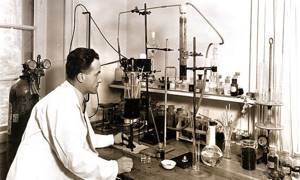
Creator of Nescafe instant coffee, chemist Max Morgenthaler at work
Although the supplier of the concentrate was different, the US military still called both instant coffee and natural coffee prepared in a filter coffee maker “Mug of Joe.” By demanding that this coffee be prepared for them, the American soldiers drove the Italian baristas into hysterics until they realized to dilute the strong espresso with water. This is how the Americano coffee recipe came about.
Discovery of the sublimation process
Scientists at the National Research Corporation (NRC), located in Massachusetts, commissioned by the military department during World War II, worked on the development of high-vacuum technologies (for producing penicillin, streptomycin, and blood plasma). It turns out that the same principle applies to instant coffee. Moreover, the concentrate frozen in a vacuum turned out to be an order of magnitude better than that dried with hot air.
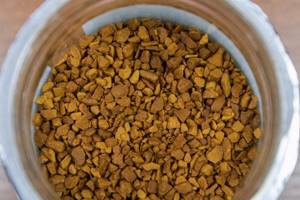
The composition of instant coffee has also improved: starting in 1954, Nescafe, and then the products of other brands, stopped stabilizing them with carbohydrates. By the 1980s, up to 40% of instant coffee from well-known brands was produced using the sublimation method.
In the 21st century, the time has come for new technologies. The legendary Don Valencia, who headed the scientific research department of Starbuks, created freeze-dried coffee that tastes as close as possible to natural coffee. Now this coffee, called Via, is added to all Pepsi coffee drinks.
History of appearance
Instant coffee has three creators. At different times, they put a lot of effort into developing the technology for its production.
- In fact, the idea of producing instant coffee appeared quite a long time ago, in 1899. Its first author was an American scientist with Japanese roots, Satori Kato. His original goal was to find a way to make instant tea. And this method was found. Then Kato decided to adapt it for coffee. This is how the first instant coffee appeared. The product turned out to be very successful and three years later it began to be produced on an industrial scale. It is interesting that instant coffee became mandatory for soldiers during the First World War. It became an integral part of soldiers' rations. But coffee beans were absolutely not suitable for this purpose. It had to be boiled, which was not possible in the field. He soon became very popular among soldiers and officers. Instant coffee powder was also issued during World War II. When peacetime came, this invention quickly entered peaceful life. Coffee lovers quickly appreciated all its benefits.
- Instant coffee first entered the world market in 1909. It was called "Red E Coffee". This was the merit of another scientist. The English inventor George Constant Washington lived in Guatemala at the time. Quite by accident, he noticed that condensation in the form of tiny coffee powder remained on the silver spoon that he took out of the cup of coffee. It was this coffee dust that gave him the idea that it was possible to create an instant version of everyone's favorite coffee.
- There is another important date in the history of instant coffee - 1938. This year became the official date of birth of the instant coffee option. It is still celebrated today. The fact is that this year Brazil had an amazingly generous coffee harvest. Despite the huge sales volumes, there were still surpluses. Coffee beans are a perishable product. When stored, they quickly lose their aromatic substances. Therefore, the problem of what to do with the surplus became extremely acute. Here, a chemist from Switzerland, Max Morgenthaler, came to the aid of the coffee magnates. It is he who is now respectfully called the father of instant coffee. He proposed obtaining a soluble powder by extraction. So Morgenthaler invented instant coffee. But his brainchild did not immediately gain popularity. Coffee connoisseurs felt that the drink made from such powder was unaromatic and without a distinct taste. By the way, they were right. Due to the fact that coffee is exposed to high temperatures, it loses a lot of aromatic oils and other beneficial substances. The final product is obtained without a pronounced taste and enchanting aroma. But the surplus still needed to be processed somehow, and the Nestle company began producing instant coffee using Morgenthaler technology. This is how the Nescafe brand was born. Now it has gained enormous popularity, but in those early years it seemed that the idea was doomed to failure.
Oddly enough, the Second World War brought instant coffee real popularity. The soldiers really appreciated him. They received instant coffee as part of their rations. It brewed quickly, infused instantly, and the soldiers received a hot and quite aromatic drink with the taste of coffee. At the front he was quickly appreciated and loved. American soldiers have become real fans of this convenient product. When the war ended, it was they who brought instant coffee into civilian life. It first gained popularity in the United States, and then quickly spread throughout the world. Thus began the triumphant march of instant coffee around the world.
Technologies for the production of instant coffee
Today, about 50% of green coffee beans are processed into instant coffee. To make it, manufacturers buy the cheapest beans: robusta and low-grade Arabica.
Based on its composition, instant coffee is divided into:
- made from 100% robusta;
- made from a mixture of Arabica and Robusta;
- containing 100% Arabica.
The beans are medium roasted (mostly American). Roasted beans should not be ground immediately, otherwise they will begin to explode. Within 3–4 hours after roasting, the coffee “rests,” releasing aromatic substances and volatile products formed when organic matter is heated. Then the grains are ground. The grains must be at least 0.5–1.1 mm in diameter, otherwise due to the high temperature they will begin to burn, giving the concentrate a burnt cork smell.
A stream of water at a temperature of +140 to +180 °C is applied to the ground grains placed in columns under high pressure. As a result, carbohydrates are washed out of coffee. When the water cools to +100 °C, aromatic substances dissolve in it. The process takes several hours. The liquid is then cooled to +40 °C. At the end of the cycle, a coffee extract containing 20–30% solids is obtained.
It is filtered and thickened using one of three methods:
- separate the water using a centrifuge;
- evaporate;
- frozen and mechanically separated the frozen water crystals from the coffee extract crystals.
The resulting thick coffee extract contains up to 40% solids, but is almost completely devoid of volatile aromatic compounds. To later impart aroma to instant coffee, manufacturers collect essential oils. This is one of the most difficult processes, since the slightest violation of technology leads to the fact that the powder acquires a musty smell.
Each manufacturer has its own secrets. Some collect aromatic substances that evaporate after roasting. Others moisten the ground coffee and heat it under reduced pressure, which releases the aromatic components. Sometimes warm nitrogen is passed through a layer of moistened ground coffee and the gas is vented into a cryochamber where the aromatic compounds are separated.
There are 2 technologies for producing instant coffee:
- spray dry - hot drying. The extract is sprayed under a stream of hot air. As a result, the moisture evaporates and powdered instant coffee is formed. If you need to make it granular, the powder is additionally treated with steam;
- freeze-dried – freeze-drying (a method for producing freeze-dried coffee). The coffee extract is pre-cooled to a temperature of –6 °C. Then it is applied in a thin layer to a drum, steel belt or pallet and frozen to a temperature of – 40 °C. If freezing occurs quickly, within 0.5–4 minutes, small light crystals are obtained. Slow freezing (10–180 minutes) produces large dark granules. Ice slabs are broken, ground and sifted. Small particles are sent for re-freezing. Large pieces of ice are placed in a vacuum chamber, where the water instantly expands. It is removed using convection.
At the last stage, instant coffee is flavored. Natural essential oils extracted from grains are added to expensive varieties, while artificial flavors are added to cheap varieties.
Instant coffee without caffeine is available on sale. It is obtained by passing green coffee bean extract through a carbon filter, which retains caffeine molecules. The cost (and therefore the price) of such coffee is more expensive than regular coffee.
Production process
The production of instant coffee is carried out in several stages:
- green grains that are unsuitable for other uses are cleaned and sorted;
- the mixture is fried for about 20 minutes, after which the grains are ground to the state of not very fine particles;
- Coffee oils are added to the dry part, which give it a characteristic aroma. Without the oils that are obtained during the roasting and brewing process, the mass will have virtually no odor;
- coffee undergoes an extraction procedure in special machines - particles pass through hot water under high pressure. This process is reminiscent of brewing coffee in a coffee machine or coffee pot, only on a larger scale;
- the entire volume of the extract is poured into large turbines, where the liquid is removed from it, and the particles are condensed, forming a concentrate;
- The concentrate is processed using the “freeze dry” technology - cold freezing. Placed in sublimators, the concentrate is atomized to create granules and frozen;
- Sugar, stabilizer, coloring pigment, flavoring are added to the finished raw materials and packaged.
Much of the flavor in instant coffee comes from oils and chemical additives. A pure fried product is unlikely to appeal to connoisseurs. It has neither smell nor taste.
How to choose instant coffee
In order not to make a mistake in choosing instant coffee, you should adhere to the following rules:
- in the store you need to meticulously examine the label: the name and design must be clear, the barcode must correspond to the country of origin;
the best instant coffee is freeze-dried, although powdered and granulated coffee can also have a pleasant taste;
- Arabica coffee tastes better than robusta coffee, but Arabica coffee has less caffeine;
- If you can smell bread notes in the coffee aroma, it means roasted barley has been added to the concentrate. It’s better not to buy this kind of coffee;
- the smell of burnt cork means that the manufacturer overcooked the beans or violated the technology when making the extract. Unfortunately, this and the previous flaw can only be discovered after purchase. But it makes sense to remember the manufacturer and not buy its products again;
- a good concentrate should be completely dissolved in water or milk.
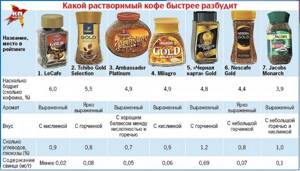
How to brew instant coffee
Its taste largely depends on the technology for preparing instant coffee. The concentrate is never poured with water heated above +90 °C. At higher temperatures, chemical flavors and other additives begin to decompose and give the coffee an unpleasant taste.
Instructions
- Warm a cup with boiling water.
- Pour instant coffee and sugar into the bottom and stir.
- Splash some hot water.
- Mix the contents of the cup thoroughly until the coffee and sugar are completely dissolved.
- Add the rest of the water.
When contacting some types of instant coffee, milk curdles. To avoid this, the concentrate is always first dissolved in a small amount of water and then milk or cream is added.
To give the drink a pleasant taste, before adding water, the concentrate can be mixed with a pinch of cinnamon, cocoa, cardamom, or anise. Latte, ice, cappuccino and other milk-coffee cocktails are prepared from instant coffee.
How to make instant coffee at home
How to make instant coffee correctly? To make instant coffee at home, you need to buy beans and roast them until golden brown. Then cool, grind and add water.
Then spread the mixture in a thin layer on parchment and place in a warm oven.
Dry until the coffee is almost dry. After this, you need to dry it a little more with a hairdryer or put it in a warm, dry place. If you overdo it, the coffee will simply burn.
When the mixture is completely dry, you can prepare your favorite cup of espresso or cappuccino. Unfortunately, at home it will not be possible to preserve the fragrant smell, and all the positive qualities will disappear with the water.
Delicious coffee recipes:
— Invigorating coffee with hazelnuts. Roast a spoonful of hazelnuts and blend in a blender. Place the resulting mass in water, then add 1 teaspoon of coffee and a little milk. Place on the stove and wait for it to boil. When finished, pour the drink into a cup through a sieve and add a little whipped cream.
— With honey and garlic, the recipe will be useful in the cold season and for colds. Melt a spoonful of honey over the fire, pour it into a glass of water and add a chopped clove of garlic. Add coffee and cook for two minutes. Turn off the heat and wait another five minutes. Then pour the cocktail into a cup through a sieve and enjoy the pleasant taste.
— Northern residents love to drink tea and coffee with salt and orange: salt retains moisture in the body, and orange, rich in vitamins, gives freshness. Mix a coffee spoon of salt, add sugar and coffee to taste, add a glass of water and cook over low heat for a couple of minutes. When finished, add a spoonful of orange juice.
— Soothing coffee with mint. Place a couple of clean chopped mint leaves in the brewed coffee, cover with a lid and wait a couple of minutes.
— Eggnog coffee with yolk. Mix two teaspoons of coffee and water in a cup. Whisk a teaspoon of cream with the yolk and a spoonful of sugar. With the mixer running, add freshly brewed coffee and beat for another minute.
— Original recipe with melted cheese. Add ½ briquette of processed cheese to half a glass of hot milk and stir until it is completely dissolved. Make half a cup of coffee, add sugar (to taste) and the resulting mass.
The benefits and harms of instant coffee
Instant coffee contains caffeine, so it affects the body in much the same way as natural coffee: it invigorates, promotes concentration, and has a diuretic effect. It is difficult to judge which coffee has more caffeine: its content in the soluble concentrate depends on the manufacturer. One 250 ml cup of instant coffee can contain from 30 to 200 mg of caffeine.
The alarming thing is that with prolonged heating, the carcinogen acrylamide is formed in the concentrate (this compound is also found in chips and some other products). Scientists say that excessive consumption of instant coffee leads to the formation of kidney stones.
Although experts argue about the benefits and harms of instant coffee, it is not recommended to drink it if you have diseases of the liver, gallbladder and pancreas. The drink contributes to dehydration of the body, which causes premature aging and darkening of the facial skin. Therefore, you should not drink more than 1-2 cups of instant coffee per day.
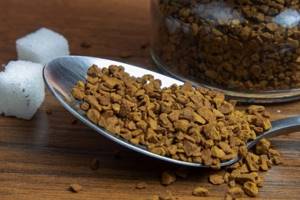
How many calories are in instant coffee?
Despite all its negative properties, coffee, like any other drink, contains virtually no calories.
:
- 100 grams of the finished product contains only 2 calories;
- If you do not want to eat dry coffee, it is better to brew it - the indicators will change slightly;
- An average cup of instant coffee, without sugar, will contain 4 calories;
- A sweet drink will take up all 8 calories;
- If the volume of the drink is more or less than 250 ml, the calorie content changes proportionally.
A couple of cups will not affect your figure in any way, and it will not satisfy your energy hunger. The situation is exactly the same with other drinks; the same tea contains virtually no calories.
The situation will change if, in addition to sugar, you add cream, milk, vanillin or something else to your coffee. Here you will have to separately calculate the calorie content of each supplement and then add up the resulting result.
In some cases, a mug can cost 400-500 calories, which is comparable to a bar of chocolate. The low calorie content of the grains themselves and the finished instant drink does not in any way affect the number of calories contained in the same sugar or cream. This should not be forgotten by those who are on a diet and trying to get rid of excess weight.
